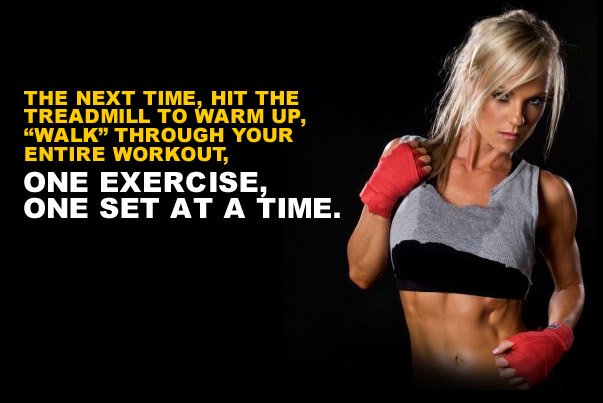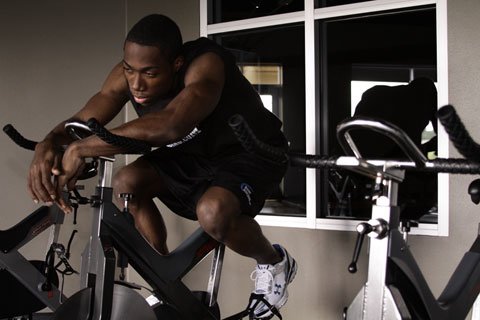
4 Ways To Banish Bad Workouts

If you're starting to dread your workouts, don't be alarmed (not yet, anyway). It's easy to fall into a slump, especially if you're feeling overwhelmed by life's daily tasks and the scale starts sticking. But this doesn't always call for a complete overhaul of your routine.
A little mental jumpstart may be all you need to get your wheels turning again so you can stick with your New Year's health resolution. Follow these motivation-boosting strategies, and you'll be back to building more muscle and burning more fat in no time.

1. UP THE BEAT WITH YOUR IPOD

The Boost:
Numerous studies confirm a strong link exists between music and improved exercise performance. According to recent research published in the Journal of Sport and Exercise Psychology, listening to music helps reduce the fatigue associated with exercise and narrows attention (i.e., focus).
A similar study conducted at Brunel University (West London, UK) found psychological arousal (the readiness of an individual to respond to stimuli) as an additional benefit. What this means is that not only does music allow you to "drown out" the tiredness that results from intense exercise, it also helps drive you to engage in this exercise.
Your Task:
Slower, calming music can quickly kill your workouts. Start by removing songs like this from your iPod, and then load up on your favourite upbeat music. Take your iPod with you every workout. When you start to feel your motivation wane, reboot by cranking it up a bit louder.

2. GO THROUGH THE MOTIONS TO REBOOT

The Boost:
Being overwhelmed by the day's tasks isn't uncommon. However, it's on these days you're more likely to push exercise aside. According to a study published in Health Psychology however, you can boost your mood and fight fatigue by doing just ten minutes of moderate exercise, such as on the bike.
Exercise is well known for its ability to significantly boost brain serotonin levels-and the more intense the exercise, the greater the production of this feel good hormone.
Your Task:
Whenever you start to dread your workout, take a ten-minute timeout on the bike or aim to complete at least one set of your favourite exercise before you pack it in for the day. Chances are, by the time you're done "going through the motions" you'll have a surge of new energy and be mentally ready to toss around the weights.

3. MAKE IT SOCIAL WITH NETWORKS

The Boost:
According to a recent study conducted at Brandeis University (Waltham, Massachusetts), social support plays a key role in health-related behaviours. Those who have supportive social relationships are more likely to engage in (and reap the benefits of) exercise.
Perhaps more important, social support encourages adherence to exercise programs. But this doesn't mean you need a training partner in order to build muscle or lose fat. You can get your social fix surfing the net.
 |
|
Online and mobile phone applications have also been found to promote healthy behaviours-especially exercise-through social support. A study conducted by researchers at the University of Washington (Seattle), working in collaboration with Intel Research Seattle, found that subjects who shared their exercise progress with friends on a mobile phone application experienced a significant boost in motivation. They concluded that these applications influence motivation through both social pressure and social support. Another reason increases in motivation may occur is that online social networks spur contact with additional resources to help facilitate healthier behaviours. Your Task: Log on daily to fitness networking sites such as BodySpace, then start recording your workout data so you can track your progress. You'll be able to see where you're making gains (or losses) at a glance, and so will all of your friends and peers-a sure-fire way to keep your motivation revving high! |
|
The Boost: Stacks of research has shown mental imagery (i.e., visualization) can push towards higher performance-but, in most cases, only in elite-level athletes. Recently however, visualization has proven just as beneficial to the average gym goer. Researchers at the University of Lyon (Villeurbanne, France) found that when subjects followed a mental rehearsal protocol during rest periods between sets-for 12 workout sessions, they gained more strength, particularly in the lower body (leg press), than those who did not rehearse. While this was in part attributed to neuromuscular adaptations that allowed for enhanced technical execution of the movement (i.e., better recruitment of motor units during muscle contraction), researchers also stated that intrinsic motivation played a significant role. Just visualizing the movement primes the brain and body to actually do it-in this case, more efficiently. An earlier study published in Memory and Cognition reported that subjects were much more motivated to take part in an activity if they had first imagined themselves actually doing it. So the clearer that picture is of yourself lifting heavy iron or sweating on the gauntlet, the more muscle you'll build or more fat you'll shed. Your Task: You don't have to wait until you're between sets to reap the benefits of visualization. The next time hit the treadmill to warm up, "walk" through your entire workout, one exercise, set, etc. at a time. But whether it's during your warm up or between sets, you want to ensure your mental image is vivid, meaning you both see the exercise and feel the muscle contraction. |
 |
|
Don't fall slump this winter and lose sight of your muscle-building or fat-loss goals. By applying these four proven strategies you can give yourself a mental tuneup and kick your New Year's health resolutions into high gear again. Apply these strategies any time you start to feel your motivation wane. References:
|



